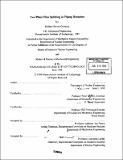| dc.contributor.advisor | Peter Griffith. | en_US |
| dc.contributor.author | Quintana, Michael Steven | en_US |
| dc.contributor.other | Massachusetts Institute of Technology. Dept. of Mechanical Engineering. | en_US |
| dc.date.accessioned | 2009-12-10T19:16:22Z | |
| dc.date.available | 2009-12-10T19:16:22Z | |
| dc.date.copyright | 1998 | en_US |
| dc.date.issued | 1998 | en_US |
| dc.identifier.uri | http://hdl.handle.net/1721.1/50127 | |
| dc.description | Thesis (S.M.)--Massachusetts Institute of Technology, Dept. of Nuclear Engineering; and, (S.M.)--Massachusetts Institute of Technology, Dept. of Mechanical Engineering, 1998. | en_US |
| dc.description | Includes bibliographical references (leaf 36). | en_US |
| dc.description.abstract | The objectives of this research are to evaluate the performance of a flow-splitting tripod, discover the factors which most affect the flow distribution; and quantify the effects of geometry, quality and flow rate on the distribution. Knowing all this allows one to predict the distribution for given conditions. An R-22 test apparatus was constructed for carrying out the experiments. The factors examined were tripod orientation, Froude number, void fraction, and swirl induced by helical grooves in the tube supplying the two-phase flow to the tripod. The flow regime of concern is primarily annular. Experiments were run and data was collected and analyzed. The two piece tripods were generally found to have manufacturing defects which made their performance unpredictable. The hole through which the flow was provided was often off center. This defect greatly affected the distribution and masked other geometric factors. To eliminate this variable a number of tripods were tested, using an air-water rig, to find a tripod that was not defective. Tests using R-22 were then run on this tripod and it was found that inlet swirl had little or no affect on the flow distribution. The factors that had the greatest effect on the flow distribution were the tripod's orientation, the Froude number of the flow, and the void fraction. An empirical correlation for flow splitting was derived including these factors. | en_US |
| dc.description.statementofresponsibility | by Michael Steven Quintana. | en_US |
| dc.format.extent | 59 leaves | en_US |
| dc.language.iso | eng | en_US |
| dc.publisher | Massachusetts Institute of Technology | en_US |
| dc.rights | M.I.T. theses are protected by
copyright. They may be viewed from this source for any purpose, but
reproduction or distribution in any format is prohibited without written
permission. See provided URL for inquiries about permission. | en_US |
| dc.rights.uri | http://dspace.mit.edu/handle/1721.1/7582 | en_US |
| dc.subject | Nuclear Engineering. | en_US |
| dc.subject | Mechanical Engineering. | en_US |
| dc.title | Two phase flow splitting in piping branches | en_US |
| dc.title.alternative | 2 phase flow splitting in piping branches | en_US |
| dc.type | Thesis | en_US |
| dc.description.degree | S.M. | en_US |
| dc.contributor.department | Massachusetts Institute of Technology. Department of Nuclear Engineering | en_US |
| dc.contributor.department | Massachusetts Institute of Technology. Department of Mechanical Engineering | |
| dc.contributor.department | Massachusetts Institute of Technology. Department of Nuclear Science and Engineering | |
| dc.identifier.oclc | 50587639 | en_US |
